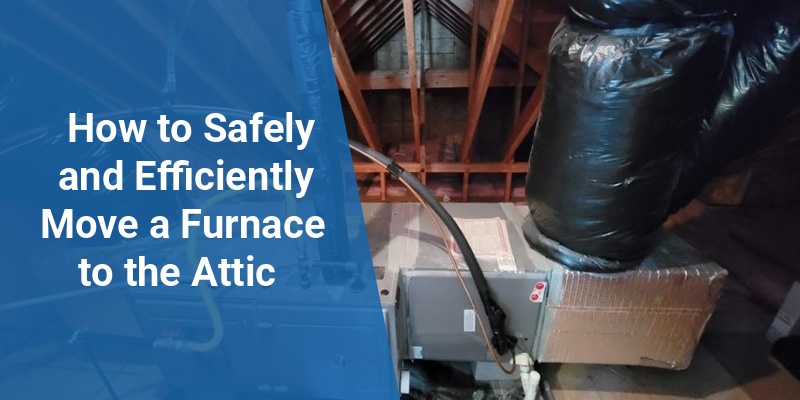Relocating a furnace to the attic can be a practical solution for homeowners seeking to maximize living space or improve heating system efficiency. However, moving a furnace to the attic requires careful planning, compliance with building codes, and professional expertise to ensure safety and optimal performance. This article explores the essential steps, considerations, and best practices involved in moving a furnace to the attic to help American homeowners make informed decisions.
| Key Considerations | Details |
|---|---|
| Space Requirements | Ensure attic space is adequate and accessible for furnace installation and maintenance |
| Ventilation and Exhaust | Proper venting systems must comply with local codes to prevent carbon monoxide buildup |
| Structural Integrity | Assess if attic floor can support furnace weight and vibration |
| Insulation and Heat Loss | Insulate ductwork and attic to maintain efficiency |
| Professional Installation | Hire licensed HVAC contractors for safe relocation and code compliance |
Assessing the Feasibility of Moving Your Furnace to the Attic
Before relocating a furnace to the attic, homeowners must evaluate whether the attic can accommodate the unit safely and efficiently. Key factors include attic size, accessibility, and current structural conditions. It is crucial to confirm that the attic floor framing can support the furnace’s weight without risking damage.
Ventilation opportunities must also be assessed, as improper venting setups can lead to dangerous carbon monoxide levels. Additionally, the attic should allow for easy furnace maintenance access by technicians. Ensuring space and structural adequacy upfront helps avoid costly issues during or after installation.
Understanding Building Codes and Permits
Relocating a furnace to an attic involves strict compliance with local building codes. Most regions require permits for HVAC modifications, enforcing standards for venting, fire safety clearances, and electrical wiring. Adhering to these regulations safeguards homeowner safety and ensures legal installation.
Key building code aspects include:
- Minimum clearance around the furnace for heat dissipation
- Proper vent stacking and chimney requirements to prevent gas leaks
- Fire-resistant materials near the furnace and ductwork
- Electrical wiring and breaker upgrades if necessary
Consulting a licensed HVAC contractor or local building authority will clarify applicable codes and necessary inspections.
Planning Attic Furnace Installation: Steps and Best Practices
Selecting the Right Furnace Type
Choosing a furnace designed for attic installation is critical. Condensing furnaces, which are energy-efficient and smaller, are often preferred. Ensure the furnace suits the attic’s environmental conditions and can operate safely at higher elevations.
Call 888-906-9139 for Free Local HVAC Quotes – No Obligation, Just Savings!
Reinforcing Attic Flooring
Attic floors often require structural reinforcement to support the heavy furnace and reduce vibrations. Adding joists or additional support beams helps maintain safety and longevity. A structural engineer’s assessment is recommended for this step.
Installing Proper Ventilation and Exhaust Systems
The furnace’s exhaust must vent outside via a chimney or direct vent, conforming to code requirements. Vent pipes need to be insulated and sealed to prevent heat loss and gas leaks. Attic ventilation should also prevent heat buildup that can impair furnace operation.
Designing Efficient Ductwork
Moving the furnace upstairs means ductwork must be redesigned to balance airflow and minimize heat loss. Using insulated and sealed ducts ensures energy efficiency. Zoning controls may be installed to optimize heating throughout the home.
Ensuring Adequate Access
Designing a service platform or access panel in the attic for regular maintenance is essential. Safe access ladders, lighting, and clearance space protect both technicians and furnace performance.
Insulation, Safety Measures, and Energy Efficiency
Proper insulation around the furnace and ductwork prevents heat loss, reducing energy bills. Attic insulation reduces the impact of temperature fluctuations on the furnace. Carbon monoxide detectors should be installed near the furnace and living spaces for safety.
Additional safety measures include smoke alarms and fire-rated materials around the installation zone.
Benefits and Drawbacks of Moving a Furnace to the Attic
| Benefits | Drawbacks |
|---|---|
| Frees up valuable floor space | Potential for heat loss if attic not insulated |
| Improves aesthetics by hiding HVAC unit | Increased risk of frozen pipes in cold climates |
| Can improve heating system efficiency with proper ductwork | Access for repairs can be more challenging |
| Reduces noise in living areas | Requires professional installation and potentially high upfront cost |
Hiring Professional HVAC Contractors for Relocation
Engaging a licensed and experienced HVAC contractor is imperative when moving a furnace to the attic. Professionals ensure that installations meet national and local codes, maintain furnace efficiency, and uphold safety standards. Homeowners should verify contractor credentials and seek multiple bids for price and scope comparisons.
Call 888-906-9139 for Free Local HVAC Quotes – No Obligation, Just Savings!
Maintenance and Inspection After Relocation
Regular upkeep post-relocation is critical to maintaining heating efficiency and safety. Schedule annual inspections to check for gas leaks, vent blockages, and duct integrity. Promptly address any signs of malfunction to prevent hazards such as carbon monoxide exposure or fire.
Common Challenges and How to Overcome Them
- Limited Attic Space: Consider downsizing the system or redesigning attic layout.
- Poor Ventilation: Install adequate vent fans or improve attic ventilation.
- Structural Weakness: Invest in professional reinforcement of attic flooring.
- High Costs: Plan budget with contingency and evaluate long-term savings from energy efficiency.
